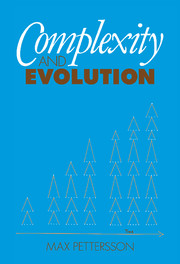Book contents
- Frontmatter
- Contents
- Foreword by Joseph Needham, FRS
- Preface
- Acknowledgements
- 1 Natural and other hierarchies
- 2 Major integrative levels
- 3 Some logarithmic forms of display
- 4 Physical range of integrated natural entities
- 5 Biological range of integrated natural entities (first part)
- 6 Biological range of integrated natural entities (second part)
- 7 Social range of integrated natural entities
- 8 Human societies (first part)
- 9 Human societies (second part)
- 10 Acceleration in evolution
- 11 Further allied accelerations
- 12 Aspects of number
- 13 Aspects of mass
- 14 Positive skewness
- 15 Quantitative conclusions
- Bibliography
- Index
5 - Biological range of integrated natural entities (first part)
Published online by Cambridge University Press: 18 January 2010
- Frontmatter
- Contents
- Foreword by Joseph Needham, FRS
- Preface
- Acknowledgements
- 1 Natural and other hierarchies
- 2 Major integrative levels
- 3 Some logarithmic forms of display
- 4 Physical range of integrated natural entities
- 5 Biological range of integrated natural entities (first part)
- 6 Biological range of integrated natural entities (second part)
- 7 Social range of integrated natural entities
- 8 Human societies (first part)
- 9 Human societies (second part)
- 10 Acceleration in evolution
- 11 Further allied accelerations
- 12 Aspects of number
- 13 Aspects of mass
- 14 Positive skewness
- 15 Quantitative conclusions
- Bibliography
- Index
Summary
Introduction
The biological range includes all individual living organisms, as well as many of their small and very small parts. Fig. 1.2 shows the first six levels of the natural hierarchy.
We must consider each of the three levels in detail. In the previous chapter some attention was paid to the structure and functioning of the physical range. Similarly it seems appropriate now to offer a very brief account of the structure and behaviour of organisms, cells, chromosomes and genes. It will also be interesting to enquire into the evolutionary origin of the organisation seen within ordinary cells. And we shall briefly review the range of mass of the members of each of these levels.
Level 6, multicellular organisms
When Robert Hooke in London published magnified pictures of sections through cork in 1665, he wrote of each tiny unit as a cellula (a little cell). That is how the biological term cell originated. Fig. 5.1 shows some cells, each with a nucleus, as seen in a section of tissue through the tip of a plant stem.
Aided by the new achromatic compound microscope of the 1830s, Schleiden and Schwann in Germany had by 1840 proposed that all larger plants and animals were composed of many tiny cells. Plants commonly have thick hard inert walls of cellulose around each cell (and running outside each cell's thin semi-permeable plasma membrane). Animal cells, however, are often separated only by their thin plasma membranes, so it took zoologists longer to become convinced of the cell theory.
Information
- Type
- Chapter
- Information
- Complexity and Evolution , pp. 40 - 52Publisher: Cambridge University PressPrint publication year: 1996
